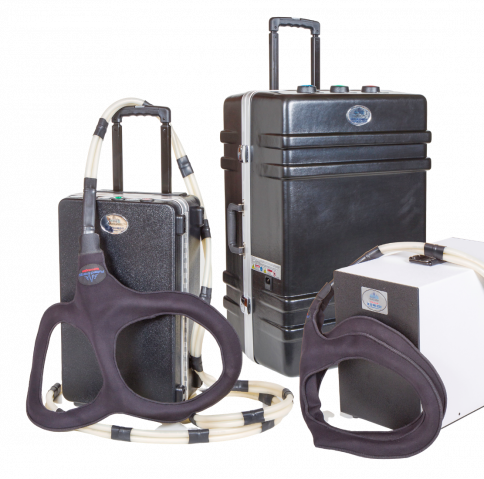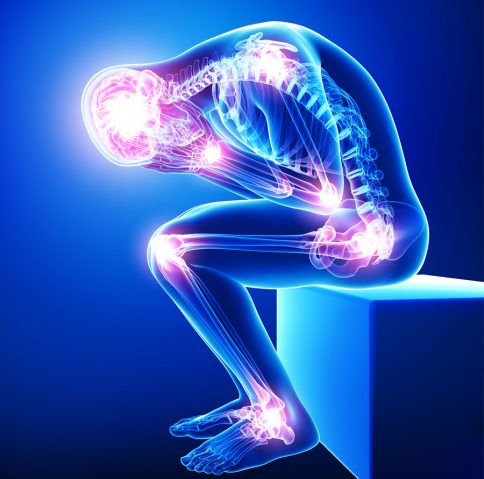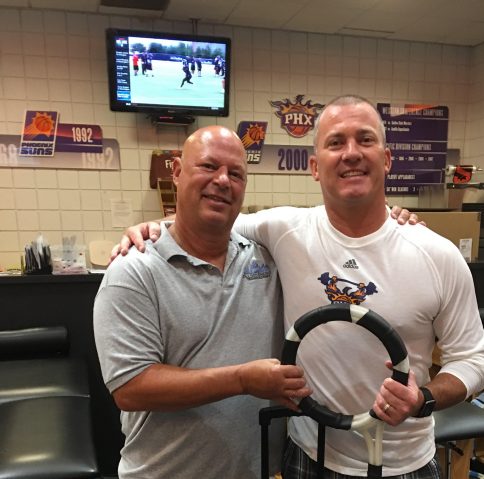Charge up your chiropractic practice (and profits) with PEMF therapy
Because chiropractic is at heart a vitalistic philosophy of healing, it has a long had a connection with the ideas about electricity, a “life-force,” and healing energy.
Often as not, all three ideas are comingled, and the history of chiropractic is colored with electric boxes and light-up gizmos, most of which relied on the gullibility of the general public for whatever efficacy they achieved. The case is quite different with pulsed electromagnetic field (PEMF) therapy.
This modality has a fairly extensive history and it has been studied and tested in well-controlled clinical trials. Furthermore, numerous peer-reviewed journal articles have reported on it favorably.1
PEMF therapy is still, in some ways, a cutting-edge modality, inasmuch as while you can code for treatments for certain conditions, doctors in the field are exploring new uses of it and making discoveries in daily practice.
Typically, these devices are rather expensive, so before making a decision you’ll want to do some homework. We met with several experts in PEMF to learn more.
From theory to reality
It’s common knowledge that DD Palmer was “the magnetic healer,” as he sought results for his patients using static magnets, in addition to providing adjustments. But the type of electromagnetic fields you can create with electricity are a much more intense form of energy than you can produce with magnets.
“It was Nikola Tesla who understood not only the more practical aspects of using these electromagnetic waves to send messages over long distances but that ‘bodily tissues are condensers,’ and also could respond to these waves in beneficial ways,” says Gary Ryan, DC, who works intensively with PEMF in his practice. He notes that in the 1890s, the American Electro-Therapeutic Association convened annual conferences centered on the therapeutic uses of electricity, which at that time was commonly used.2
Tesla founded the Tesla Ozone Company in 1900, and sold his ozone generators to doctors who were experimenting with ozone therapy.
Josh Silver, president and CEO of Pulsed Energy Technologies, points out that, “Back in 1912, Nikola Tesla founded the Tesla Electrotherapeutic Company. His device was very rudimentary, creating plasma, and through 1932, Tesla and H.G. Fischer produced electrotherapy devices for sale. You could buy these through the mail and at department stores.” This would ultimately be Tesla’s most profitable line of business.
It should borne in mind that in those early days, electromagnetism was thought to have medical benefits, but the practitioners involved didn’t clearly understand what they were doing and were operating by intuition. That story remains fairly static until around 1950. “An Italian electrical engineer, Antoine Prioré, worked between 1950 and 1975 on electromagnetic devices similar to today’s units, although up until about 1972 there was no differentiation between electromagnetic field (EMF) and pulsed electromagnetic field (PEMF) devices,” Silver says.
Jason Tebeau, president of Da Vinci Medical Inc., offers additional details: “When the first astronauts and cosmonauts were placed in orbit in the 1960s to 1970s, within hours they became emotionally, mentally, and physically impaired, and on long space flights they would lose a considerable amount of their bone density.” It was speculated that being removed from Earth’s electromagnetic field was the culprit. “NASA began exploring PEMF generators in 2005 to simulate the Earth’s magnetic field and address the problem of space sickness and orbital bone loss.”3
Mechanism of efficacy
Studies on whether humans can detect magnetic fields and sense compass directions have been mixed.4 There is no question, though, that many animals have evolved magnetoreceptors and cryptochromatic cells to aid with complex navigational tasks.
“In the early 1970s, Gianni Dotto got the first patents for EMF therapy devices. Today there are some 10 different versions of EMF but our term is PEMF,” Silver says. It was in the 1970s that scientists proved that surrounding a fractured bone with EMF facilitated healing, both in the speed and quality of repair.
“It optimizes the body’s self-healing and self-regulating functions and supports the restoration of cells to normal function. It has been shown to increase tissue oxygen and expel toxins,” Ryan says. Not unlike the way low level laser therapy energizes cellular mitochondria, it is thought that PEMF similarly stimulates the body’s cells and encourages a return to normal function.
Ryan observes that inflammation is normally the body’s immediate response to an injury, and it occurs as the injury site is flooded with white blood cells. PEMF may work in a similar way, either alerting the body to marshal resources in a given area, or enhancing the activity of white blood cells—or both.
Tebeau cautions that “PEMF devices do not diagnose, treat, or cure a single disease. The energy they generate augments the body’s native cellular energy due to aspects of quantum physics, naturally and without side effects.”
This aligns well with chiropractic philosophy, which consistently looks to encourage the body’s innate healing ability with non-invasive approaches.
“We auditioned for Shark Tank, and they wanted a one-word explanation,” Silver says. “We came up with homeostasis. Every cell that has an injury has a reduced membrane potential, and we know electricity goes through the cells.” He gives the example of treating a shoulder, in which bringing the treatment attachment of the PEMF unit to the site of the injury results in a cascade of functions. “And each pulse of energy increases oxygen and blood flow, so that when the electromagnetic field affects the cell, it goes back to performing its original function,” he says.
Where PEMF shines
Theoretically, wounds, bone fractures, any area of chronic injury and pain can be a viable target for PEMF therapy.
But there are additional areas where it can be considered appropriate. Ryan points out that PEMF shouldn’t be thought of as “treating” conditions, but rather as a modality that “optimizes the self-healing environment.”
Tebeau concurs: “It’s applicable anywhere the potential exists for the body to repair itself. If you badly break your leg in an accident, you will need an emergency room doctor to put a pin in your leg to hold it together. But, once home, PEMF will give the body the energy it needs to undertake the repairs the rest of the way, if possible.”
The majority of evidence for PEMF and its primary FDA clearances are for osteogenesis, or non-invasive bone growth and repair.5 In 2011, the FDA also cleared PEMF for treating depres- sion in patients who fail to respond to pharmacological therapy.
“We’ve found that genetic disorders don’t respond to treatment,” Silver says. “But we might see pain reduction. Partial ligament tears and cartilage and muscle respond very well to the machine. We build and strengthen the muscle with magnetic induction and heal it with pulsed electromagnetic field therapy.”
What Silver refers to here is that at higher intensity levels, patients can feel a pulsing sensation and muscular twitching. The effect is moderate, however, and not painful at all. But given this amount of energy, PEMF will interact with pacemakers and cannot be used with patients who have them.
PEMF in practice
As this is a relatively new modality in clinical settings, most patients will be unfamiliar with PEMF; they’ll need to be informed of expected outcomes. According to Tebeau, “Results can range anywhere from zero benefit to 100- percent resolution,” but in his experience, you can expect to elicit a good-to-very-good response at least 80 percent of the time. Factors to consider are the patient’s condition, severity, progression time, age, and overall health.
“Everybody using the machine the first time will get some kind of experience from it,” Silver says. “It could be 2 percent or 100-percent pain relief. Typically, people with long-term chronic disease will take longer to respond.”
Given what is known about PEMF at this time, treatment of persistent wounds, pain, swelling, and range-of-motion improvement are things you can advertise to potential patients, and areas where they should respond favorably.
It’s notable that this modality has been broadly adopted by professional sports teams, whose trainers and medical staff are always looking for non-pharmacological and non- invasive solutions to pain and injuries. And PEMF has made major inroads into veterinary medicine, where patients definitely aren’t responding to a placebo effect.6,7
Treatment protocols
As you would expect, how you approach providing this type of therapy will depend on a patient’s presenting issue. In general terms, however, you’ll apply treatments across a number of sessions. Tebeau notes that, normally speaking, the four key factors that influence outcomes are the applicator used, how the applicator is positioned, the number of minutes the device is run, and the intensity setting selected.
Ryan has seen patients with chronic pain benefit from a single session. “But typically, for long-lasting full-body benefits, a program of three hours a week for 17 weeks, totaling 51 hours, can lead to remarkable outcomes,” he says.
Ryan has also found programs of 15 or 20 hours to be popular, and patients can sit and read or watch TV after the CA sets up the equipment and accessories. “It’s not unusual for patients to find the treatment so relaxing they doze off,” he says. The DC, meanwhile, can attend to other patients.
As with any other modality, you adjust your approach in accord with the patient’s response. The DCs Silver works with will typically provide treaments two to three times per week, for about 12 sessions in a month. “Then you’ll know about how much progress is likely to be possible.”
Marketing methods
If you have experience with providing low level laser therapy, you’ll find that marketing and ROI considerations with PEMF are fairly similar. Advertise to your target market, develop skill with the craft, and the number of treatments you provide times the cost of a session will determine where you break even on your investment.
Most companies offering PEMF equipment will have a range of marketing materials to assist you. These include flyers, print ads, videos, and testimonials, as well as online graphics and information for your website.
“If you’re a DC and you want to include it as part of the adjustment process, some of our DCs will put the patient on PEMF for about 10 minutes prior to the adjustment; it loosens the patient, it makes the adjustment easier,” Ryan says. Then, post-adjustment, they’ll put the patient back on for 10 to 15 minutes, as it helps the adjustment hold.
One way to gain new patients is to offer the first few treatments on a trial basis, to let them experience the effect and judge for themselves if this is a solution that works for them.
Training for success
All of the experts we consulted stressed the importance of training. Doctors who fail to obtain effective results with PEMF are generally not providing treatments properly. To this end, the manufacturer-provided training programs are integral to successful outcomes.
Silver offers certification to providers who complete his course. “It’s different by state, but in most cases the person providing the treatment needs to be certified. In addition to DCs, PTs, certified physical therapists, and athletic trainers are all using this equipment.”
The PEMF vendor Ryan chose has product specialists who train DCs and their staff, in addition to online coursework and certification. “The product specialists dive a little deeper, answer questions, and walk you through how to use the system to get the best possible benefits in your practice,” he says.
New owners of PEMF equipment will typically have questions involving the various positions for the treatment accessories, such as wands, mats, loops, and headbands. If you have a question about treating a particular condition, the manufacturer will generally refer you to another practitioner working in that area, so you can exchange ideas directly.
Niche opportunity
Although PEMF is used widely in Europe, it’s still relatively unknown in the U.S. healthcare market. Doctors who offer it here will often have little competition. According to Ryan, a distinct advantage is the speed at which this therapy works. “People notice a difference in how they feel right away. It works for such a wide range of patients a doctor sees on any given day.”
There is a considerable body of literature about PEMF, and those with interest will find research covering the treatment of vascular disorders, inflammation and edema reduction, enhanced rates of healing in skin grafts, treatment of neuropathy, and more. Depending on the type of patients who constitute your core demographic, you may find this modality to align with the needs of your practice.
References:
1 C, Richards T. Evolution of magnetic therapy from alternative to traditional medicine. Phys Med Rehabil Clin N Am. 1999;10(3):729-54.
2 The American Electro-Therapeutic Association. (1899). Proceedings of the American Electro-Therapeutic Association. William Briggs: Toronto.
3 Byerly D, et al. Pulsed Electromagnetic Fields—A Countermeasure for Bone Loss and Muscle Atrophy. Space Life Sciences. Aug. 2005.
4 Baker RR. Goal orientation by blindfolded humans after long-distance displacement: possible involvement of a magnetic sense. Science.
1980;210(4469):555-7.
5 Food and Drug Administration Executive Summary. “Reclassification Petition for the Non-invasive Bone Growth Stimulator.” http://www.fda.gov/ohrms/dockets/ac/06/briefing/2006-4224b1-10-TabE- FDA-Executive-Summary.pdf . Published June 2006. Accessed Jan. 2017.
6 Orgel MG, O’Brien WJ, Murray HM. Pulsing electromagnetic field therapy in nerve regeneration: an experimental study in the cat. Plast Reconstr Surg. 1984;73(2):173-83.
7 Canè V1, Botti P, Soana S. Pulsed magnetic fields improve osteoblast activity during the repair of an experimental osseous defect. J Orthop Res. 1993;11(5):664-70.





